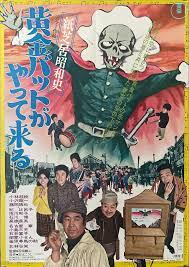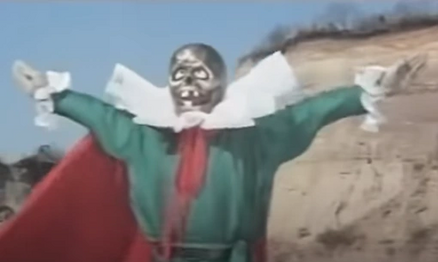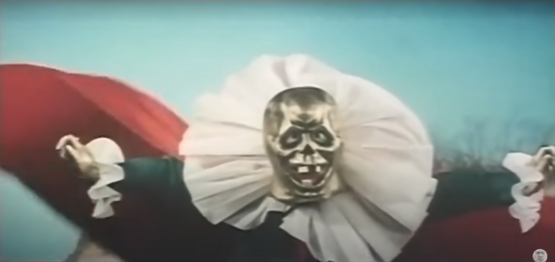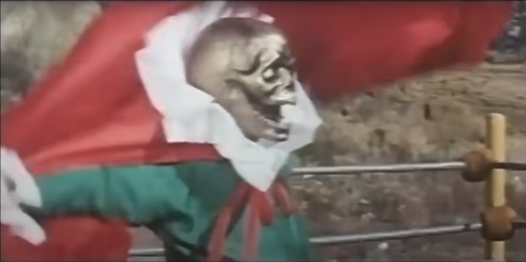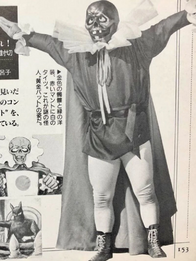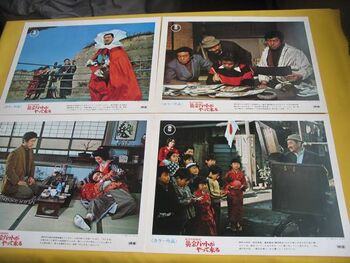The Golden Bat Is Here! (partially found tokusatsu comedy film; 1972)
The Golden Bat Is Here!, also known as Here Comes Golden Bat! or The Golden Bat Shows Up![1] (黄金バットがやってくる Ôgon Batto ga Yattekuru), is a comedy film based on the Golden Bat franchise itself, released on May 13th, 1972 by Toho Studios. Very little information on the film survives despite being produced by a studio as large as Toho[2]. The film has seemingly never been released on VHS or DVD and airings of it were incredibly scarce and non-existent. The film ran on 2,501m reels when it was released in theatres.[3]
Plot
Most summaries simply state that the film depicts the history of kamishibai (picture storytelling), showing how Golden Bat was hugely popular with children, how during the war Golden Bat took on a spiky design and became a picture story about the Americans and British, and how kamishibai fell out of fashion with the spread of television and other media and also mainly focusing on the titular hero and his origins.[4] However, multiple sources claim that the film portrayed Golden Bat as being "fat and incompetent".[5][6][7]
According to an old Japanese site dating all the way back to 2006, the film's plot was as follows:
"The film starts with a scene in which Kobayashi Keiju, an abnormally old art student, faints from hunger after watching Fujitaku's kamishibai in the park. At Fujitaku's house, Keiju gobbles down two bowls of rice. He feels like the Naked General. Having his drawing skills recognized, Keiju becomes a kamishibai artist through Fujitaku's introduction to the father-son duo Kitabayashi Tae and Ozawa Shoichi, who are notorious kamishibai bosses, and eventually creates the hit "Golden Bat." This is the story of the rise and fall of the Kamishibai industry.
There are a series of strange situations, such as Katsura, who is apparently middle-aged, being a young man in his early 30s, and the love triangle between Katsura and Shoichi, but that's because this film is a historical drama that depicts the prewar period, wartime, and the emergence of television after the war. As the story progresses, the sense of incongruity disappears. Among the cast, Ozawa Shoichi is brilliant in his C-type role of "fake leftist before the war → smuggler of goods during the war → fake 30 people just after the war → president of a fake entertainment agency after the war" with plenty of "Ozawa Shoichi heart". Our Fujitaku gives a great performance in a picture-story show to support his wife and children. There are some scenes that Fujitaka fans will not be able to stand, such as when he becomes so absorbed in Kamishibai that he transforms into Golden Bat in his imagination, and then fights Nazo in a one-on-one ring, and after winning, shares a warm embrace with his wife, Tomiko Ishii.
While this work is supposed to be a comedy, the end is a tragic scene showing the decline of the Kamishibai industry due to the rise of television. To top it off, Fujitaka is hit by a car on his way to the "Nostalgic Kamishibai Competition" venue and dies instantly."[8]
Cast
- Tokuhei Kyojima: Keiju Kobayashi
- Zenkichi Sugano and Golden Bat: Takuya Fujioka
- Megumi: Kihiroko
- Toru Katayama: Hiroshi Ishikawa
- Kiyoko: Kazuko Ichikawa
- Masako: Tomiko Ishii
- Shigeo Saeki: Choei Takahashi
- Seitaro Marukawa: Shoichi Ozawa
- Gin: Kitabayashi Yae
- Floating Boat: Mitsuyo Inomata
- Waitress: Tamami Urayama
- Bicycle shop: Junpei Natsuki
- Wife: Matsue Ono
- Kondo: Tadayoshi Ueda
- Teshima: Yasuzo Ogawa
- Matsuno: Wataru Ohmae
- Shimizu: Miki Kojima
- Mishima: Umezu Sakae
- Venue: Kosen Yanagiya (4th generation)
- Hall attendant: Sachiko Mori
- Moderator: Kaneharatei Umanosuke (first generation)
- Detectives: Naoya Kusakawa and Saburo Kadowaki
- Tax office employee: Akira Nagoya
- Kinoshita: Yoshio Katsube
Availability
No known releases of the film exist, with the only footage that exists of it being roughly two minutes taken from a VHS recording of the film on TV. This footage was uploaded on its own in the past, but as of now, the upload was removed and the rest remained lost since prior to May 2024, when LMW user Fantomah (Zoobotnik on his main account outside of this Wiki), the founder and owner of The Golden Bat Wiki, discovered the above footage on Twitter alongside more information about the plot of the film[9][10] It's possible a copy still exists within Toho's archives, but a statement, either way, has never been made.
In 23 July 2024, the aforementioned user discovered that an official soundtrack release for the film exists also containing a few more photos from the film in the packaging. The release is impossible to obtain and 2 known copies were long ago sold and the buyers never posted the audio online.[11][12]
You can see more stills from the film here.
Gallery
Images
Videos
Notes
- The film is not to be confused with the film The Golden Bat! that was released in 1966 and directed by Hajime Sato.
See Also
- Golden Bat: The Phantom of the Skyscraper (lost tokusatsu film adaptation based on Kamishibai character; 1950)
- Phantoma Phantaman: Warrior of Justice (partially found English dub of "Ōgon Bat" anime series; 1967)
References
- ↑ https://flickr.com/photos/bekon/62434665
- ↑ Takaki, Junzo; Matsunomoto, Kazuhiro; Nakamura, Satoshi; Motoyama, Sho; Tsuchiya, Rieko (1999). The Godzilla Chronicles(in Japanese) (3rd ed.). Takeshobo. p. 169. ISBN 4-8124-0581-5.
- ↑ http://jmdb.ne.jp/1972/cv001460.htm
- ↑ https://ameblo.jp/ayashii-museum/entry-12307064266.html
- ↑ http://internationalhero.co.uk/o/ogonbat.htm
- ↑ http://calvinscanadiancaveofcool.blogspot.com/2014/11/golden-bat-japans-first-superhero.html
- ↑ http://tarstarkas.net/2013/10/the-golden-bat/
- ↑ http://akapen.blog44.fc2.com/blog-entry-76.html
- ↑ https://x.com/furifuri66/status/1698689710334583188
- ↑ http://akapen.blog44.fc2.com/blog-entry-76.html
- ↑ https://ekizo.mandarake.co.jp/auction/item/itemInfoJa.html?index=290528
- ↑ https://aucview.com/yahoo/e192337982/
